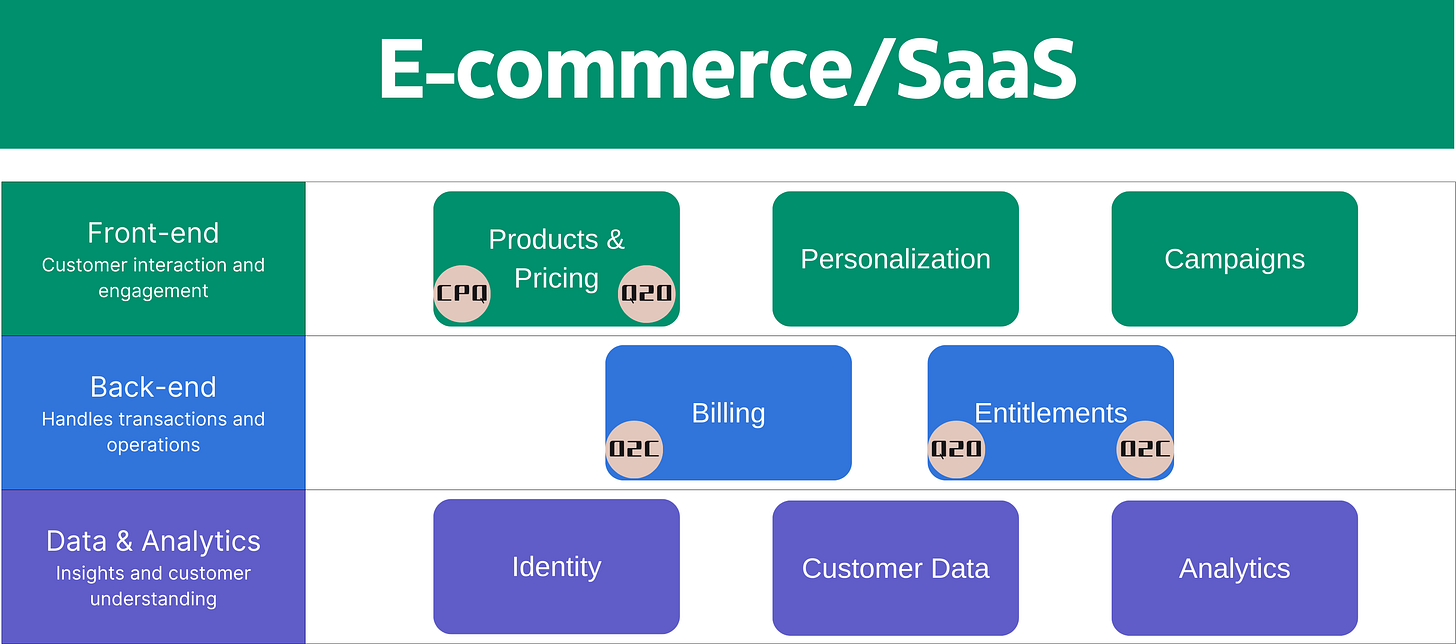[E]Commerce 101: Architecture.
Behind the Scenes: The Architecture Powering E-Commerce

Introduction
Products are often sold through multiple sales channels, or “storefronts,” each with unique marketing and point-of-sale surfaces. Managing these channels typically spans teams, organizations, and even company boundaries. Each storefront is powered by a diverse set of Revenue and Engagement services—collectively referred to as the “Commerce Platform”(sometimes also “Growth Platform”).
The Platform
1. Customer Experience Layer
Focuses on customer interaction and engagement.
Products & Pricing
Functionality:
Manage catalog, pricing, incentives, and SKU relationships in a centralized system.
Enable dynamic pricing models, experimental price testing, and reseller-specific discounts.
Challenges:
Marketplaces: Managing Region-Specific Pricing and Availability Across Multiple Sellers
Implementing geographical pricing involves adjusting prices based on local market demand, taxes, and shipping costs, which can be complex in diverse regions. [Geographical Pricing Explained: How Location Impacts Prices]
Subscription-Based Storefronts: Configuring Trials, Upgrades, and Add-Ons Dynamically
Offering flexible subscription models with trials and add-ons requires sophisticated billing systems to manage various customer preferences and billing cycles. [The Challenges of a Subscription-Based Business Model]
Personalization
Functionality:
Deliver tailored recommendations, dynamic offers, and notifications.
Provide experimentation tools to optimize personalized content.
Challenges:
Traditional E-Commerce: Generic Recommendations Limit Engagement
Without personalized recommendations, customers may experience irrelevant product suggestions, leading to decreased engagement and sales. [The 12 Biggest Pricing Challenges]
Social Media Storefronts: Limited Ability to Personalize Shopping In-App
Integrating personalized shopping experiences within social media platforms can be challenging due to data privacy concerns and platform restrictions. [Why Localized, Store-Specific Pricing and Availability Insights is Critical for Consumer Brands]
2. Commerce Operations Layer
Manages workflows, entitlements, and payment optimization.
Billing & Revenue Management
Functionality:
Support flexible billing models (one-time, recurring, usage-based).
Federate billing across providers and automate revenue recognition.
Use payment retries and dunning strategies to reduce revenue leakage.
Automate multi-step workflows (purchase, provisioning, refunds).
Detect and resolve errors in processes with reusable, composable workflows.
Challenges:
Marketplaces: Ensuring Accurate Revenue Sharing Among Sellers
Accurately distributing revenue among multiple sellers requires transparent and efficient systems to handle complex transactions. [How B2B Marketplaces Are Rewriting the Rules of Trade]
Custom-Built Storefronts: High Error Rates in Manual Order Workflows
Manual order processing is prone to errors, leading to delays and customer dissatisfaction. [7 Software Implementation Challenges & How to Solve Them]
Subscription-Based Storefronts: Managing Complex Billing Schedules
Handling various subscription tiers, billing cycles, and payment methods can be challenging without robust billing systems. [5 Recurring Billing Challenges and How to Overcome Them]
Entitlements & Provisioning
Functionality:
Centralized management of user entitlements, groups, and access.
Automate provisioning of subscriptions and track feature compliance.
Challenges:
SaaS Storefronts: Difficulty Integrating Entitlement Changes Across Systems
Synchronizing entitlement updates across various platforms can lead to inconsistencies and access issues. [7 Software Implementation Challenges & How to Solve Them]
App Stores: Synchronizing Entitlement Changes with External Platforms
Coordinating entitlement changes with third-party app stores requires seamless integration to ensure user access is up-to-date. [Mastering Multichannel Management: 10 Strategies for Overcoming Challenges]
3. Data Management & Intelligence Layer
Centralizes customer data, identity, and operational insights.
Identity
Functionality:
Maintain a canonical representation of users through a universal directory.
Provide membership and access management primitives (e.g., Groups and Resources).
Validate user authentication and ensure seamless interaction across systems.
Challenges:
Marketplace Storefronts: Identity Federation Across Different Marketplaces
Integrating user identities across various marketplaces requires robust federation protocols to maintain consistency. [Identity Federation Governance]
Social Media Storefronts: Data Alignment Issues with External CRMs
Integrating social media interactions with external CRM systems can lead to data misalignment, affecting customer insights. [13 Tips To Connect And Integrate CRM Tools And Social Media Efforts]
Client App Storefronts: Seamless Transition of Subscriptions and Roles Across Devices
Ensuring that user subscriptions, entitlements, and roles are consistently maintained across multiple devices poses technical challenges. [Identity Management Challenges for Retailers]
Customer Data Platform (CDP)
Functionality:
Build unified customer profiles by aggregating data from various touchpoints.
Segment customers for targeted marketing initiatives.
Orchestrate campaigns, customer journeys, and multi-channel communications.
Provide actionable insights to drive customer retention and acquisition strategies.
Challenges:
Social Media Storefronts: Limited Access to First-Party Data for Targeting
Social media platforms often restrict access to granular user data, hindering personalized marketing efforts.[First-Party Data: The Benefits and Challenges for Marketers]
Marketplaces: Fragmented Customer Insights Due to Siloed Seller Data
Data silos across different sellers prevent a holistic view of customer behavior and preferences.
Analytics & Reports
Functionality:
Provide real-time dashboards displaying revenue, campaign performance, and operational metrics.
Enable predictive analytics to identify opportunities for upselling and to mitigate customer churn.
Challenges:
Dropshipping: Lack of Visibility into Supplier Performance Metrics
Dropshipping models often suffer from insufficient data on supplier reliability, affecting inventory management and customer satisfaction.[Supplier Performance Measurement Challenges: A Detailed Analysis]
Traditional E-Commerce: Manual and Inconsistent Campaign Performance Reporting
Relying on manual processes for campaign reporting leads to inconsistencies and delays in decision-making.
So, what ?
The secret to a thriving e-commerce platform isn’t just the tools—it’s how you manage them. Success lies in centralized governance, industry standards, and powerful analytics that empower smarter decisions. Here’s how to make it happen:
Centralize for Control and Consistency
Use the single playbook guiding every product update, pricing tweak, and campaign launch. With unified governance, you eliminate silos, ensure consistency, and make collaboration seamless across teams and storefronts.Speak the Same Language with Industry Standards
Don’t reinvent the wheel. Use frameworks like SCIM for identity management or RACI to define team roles clearly. Standardized approaches let you focus on growth, not operational chaos, while ensuring your platform scales effortlessly.Let Data Lead the Way
Data isn’t just numbers—it’s your strategy’s backbone. Build real-time dashboards that tell you what’s working and what’s not, and use predictive analytics to stay ahead of churn and seize new opportunities. Insights like these turn guesswork into growth.
By putting governance, standards, and analytics at the heart of your platform, you’re not just building for today—you’re setting the stage for lasting success. It’s time to make your e-commerce ecosystem smarter, faster, and ready to thrive.


